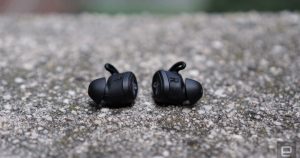When Twitter suddenly announced it was shutting down Vine in 2016, fans immediately started campaigning to bring the beloved short-form video app back. Dom Hofmann, one of the original cofounders, has been working on doing just that for years. After a few stops and starts, his new app Byte finally launched last week. It already has 1.3 million downloads, according to Sensor Tower. It also appears to have learned some lessons from Vine’s demise, but that won’t necessarily be enough for another social video app to survive in 2020.
Vine’s six-second format was a novelty when it came out in 2012, and the limitation birthed a unique, off-the-wall style of comedy. The app incubated some of the internet’s biggest celebrities, including singer Shawn Mendes, comedian Brittany Furlan, and Logan and Jake Paul. But as obituaries for the service noted, it didn’t do enough to support its rising stars and was often criticized for overlooking creators of color. Many eventually left for platforms where they could create longer content and make more money, like YouTube and Instagram.
This time around, Hofmann and his team are trying to do things differently. Byte’s tagline is “creativity first,” and the company appears to be prioritizing creators from the start. There’s a dedicated forum where they can discuss issues with one another and Byte staff, creating a more personal feel than larger platforms. Hofmann told TechCrunch he plans to give creators a cut of profits, though the exact details on how the program will work haven’t been released. Byte did not respond to a request for comment from WIRED.
A lot has changed since Vine died. Instagram Stories exploded in popularity, and TikTok has entered the scene. The Chinese-owned app has been downloaded over 1 billion times, propelled by a powerful algorithm that makes it easy to lose hours to the app. Like Vine before it, TikTok’s features have given rise to new meme formats, uber-viral stars, and even Los Angeles mansions filled with creators. People might still miss Vine, but some see the six-second video as a format whose time has mostly passed.
“It was so interesting because it was so new and different. They created this whole new type of content that’s been expanded and has evolved,” says James Nord, the CEO of Fohr, an influencer marketing platform. “I don’t know that nostalgia on the internet is a business plan.”
It’s unclear what a long-term business plan for Byte might look like. Unlike YouTube and Instagram, the platform is mainly a place for comedy sketches and stunts. That’s not the type of content most brands are comfortable working with creators to produce, says Nord. Brands have a hard time being genuinely funny, and it’s not exactly easy for a creator to give an authentic product testimonial in six seconds.
Beyond making money, creators will need to work with Byte’s stripped-down design. Unlike TikTok, Byte doesn’t have filters or elaborate in-app editing tools, and you can’t add music clips to videos. If you’re used to watching TikTok, the lack of pre-programmed sounds on Byte can seem, well, quiet. Bytes also often feel super short. Brevity is what made Vine unique but could limit the scope of content on Byte. A few seconds is probably not long enough to film a cooking or makeup tutorial—two genres that have flourished on TikTok.
Not every creator is dissuaded by those limitations. “We explore every platform to see if it’ll be a right fit for our brand,” says Jacob Pace, the CEO of Flighthouse, a media company with more than 22 million followers on TikTok. Byte “might have a space since it’s different (though shorter) than other short-form mobile social media apps.”
So far, Byte’s users have begun populating the platform with the same breed of weird humor that made Vine famous. A clip edited to make Kanye West look like he’s FaceTiming with a hamster. A girl crashing into a bush while riding in a Target shopping cart. Shrek vibing to rap music. It’s hard to say anything definitive about a new platform, especially when content may be individualized, but a cursory look at Byte’s Popular section suggests many users are older than Generation Z.
Stumbling upon new creators isn’t easy, due to Byte’s limited discovery mechanisms. The home screen is essentially videos from people you choose to follow, but there are also a small number of computer-chosen clips, which are labeled “For Your Consideration.” Users can find more creators under the search tab by clicking playlists like “Your Mix,” “Popular Now,” and “Latest.” Overall, it’s harder to find new content on Byte than on TikTok, where the For You algorithm easily sucks users in.
Curiously, there are no public follower counts on Byte. To compensate for the loss, many users are self-reporting their own numbers in their bios. That could prove to be an issue in the long run, says Nord, because there isn’t a way for influencers to easily verify the size of their audiences. “Snapchat didn’t show you how many followers you had and did nothing to help you gain a following,” he says. As a result, many influencers left for Instagram Stories.
Eschewing follower numbers helps put the focus on each individual video. Users can still see exactly how many likes and comments each clip gets. Instead of displaying 17.5k when a video has roughly 17,500 views, Byte will show everyone it has 17,489 … then 17,490 … then 17,491, updating in real time. “Including this kind of specificity encourages users to focus on every single increment of that metric,” says Ben Grosser, a professor of new media at the University of Illinois at Urbana-Champaign and the artist behind Demetricator, a tool that strips social media platforms of their metrics. “In other words, it’s meant to keep us engaged, in an endless search for +1.”
It’s hard to say whether any of these choices will determine the culture of Byte. Vine is remembered largely as a joyous platform. But it shut down before the 2016 presidential election and didn’t suffer from the same content moderation scandals as platforms like Facebook and YouTube. That’s a hard reputation to try to live up to.
Vine is like vinyl records, says Nord: niche and mainly nostalgic. “I think it’s a similar thing where it just feels like that time has probably passed,” he says. But hey, vinyl has experienced a renaissance among younger music listeners in recent years. There’s still some hope that the six-second loop could come back, too.
More Great WIRED Stories
- The bird “snarge” menacing air travel
- Chris Evans goes to Washington
- I thought my kids were dying. They just had croup
- How to buy used gear on eBay—the smart, safe way
- All the ways Facebook tracks you—and how to limit it
- 👁 The secret history of facial recognition. Plus, the latest news on AI
- 🏃🏽♀️ Want the best tools to get healthy? Check out our Gear team’s picks for the best fitness trackers, running gear (including shoes and socks), and best headphones


